Research and Analysis Paper on Amazon: Part II
VerifiedAdded on 2023/01/18
|12
|2426
|55
AI Summary
This paper is an extension of the previous paper on critical analysis of Amazon as the e-Commerce giant. Here focus will be given on strategy formulation based on SWOT analysis, environmental constraints, stakeholder analysis, organizational structure and design, employee motivation, recommendations and final control measures.
Contribute Materials
Your contribution can guide someone’s learning journey. Share your
documents today.

Running Head: INTRODUCTION TO MANAGEMENT
Topic- Research and analysis paper: Part II
Student name
University name
Author notes
Topic- Research and analysis paper: Part II
Student name
University name
Author notes
Secure Best Marks with AI Grader
Need help grading? Try our AI Grader for instant feedback on your assignments.

2INTRODUCTION TO MANAGEMENT
Table of contents
Summary..........................................................................................................................................3
SWOT- Formulating strategies........................................................................................................3
Environmental constraints...............................................................................................................4
Stakeholders.....................................................................................................................................5
Organizational structure and design................................................................................................5
Motivating employees.....................................................................................................................6
Recommendations............................................................................................................................6
Controls............................................................................................................................................7
References........................................................................................................................................8
Appendix........................................................................................................................................10
Table of contents
Summary..........................................................................................................................................3
SWOT- Formulating strategies........................................................................................................3
Environmental constraints...............................................................................................................4
Stakeholders.....................................................................................................................................5
Organizational structure and design................................................................................................5
Motivating employees.....................................................................................................................6
Recommendations............................................................................................................................6
Controls............................................................................................................................................7
References........................................................................................................................................8
Appendix........................................................................................................................................10
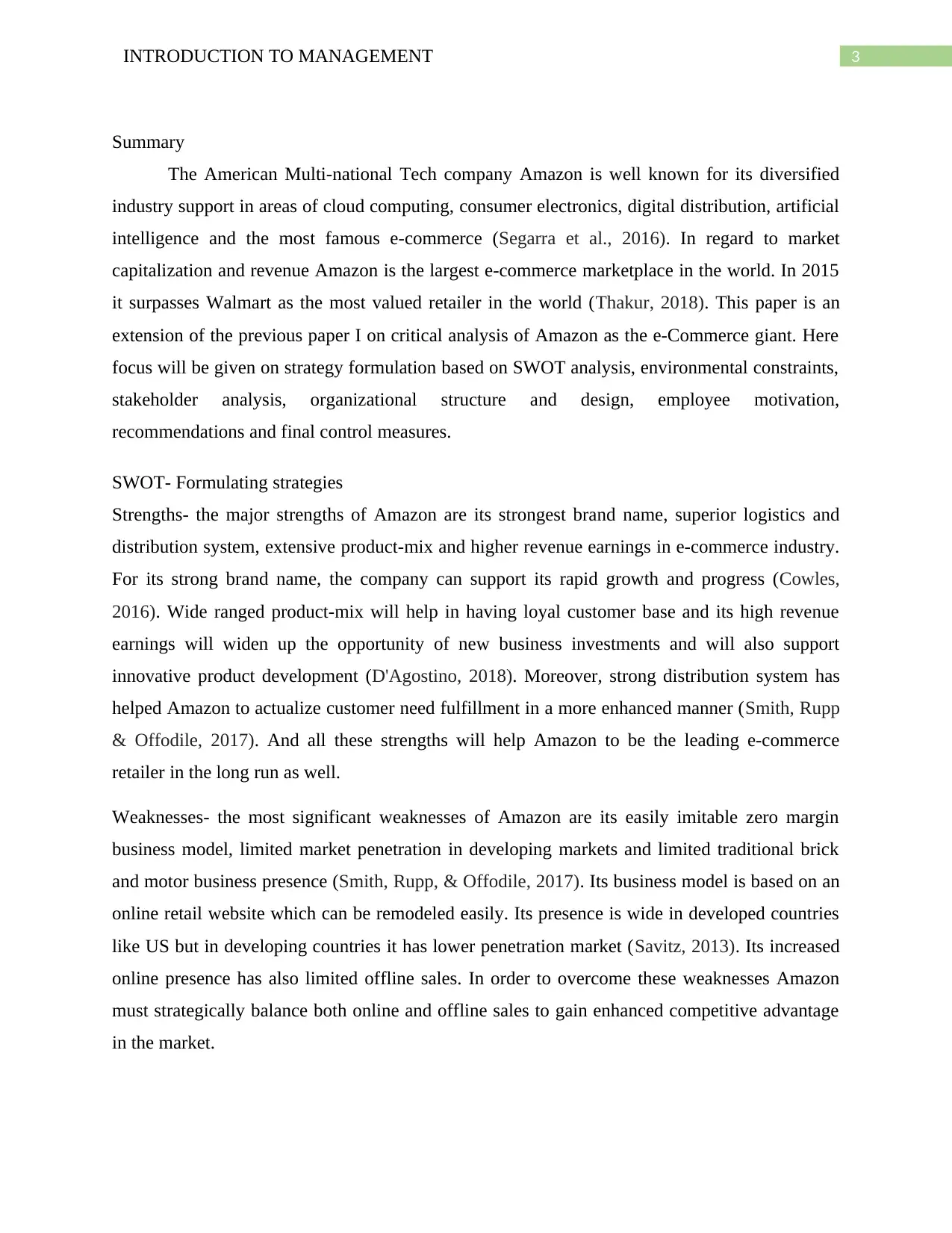
3INTRODUCTION TO MANAGEMENT
Summary
The American Multi-national Tech company Amazon is well known for its diversified
industry support in areas of cloud computing, consumer electronics, digital distribution, artificial
intelligence and the most famous e-commerce (Segarra et al., 2016). In regard to market
capitalization and revenue Amazon is the largest e-commerce marketplace in the world. In 2015
it surpasses Walmart as the most valued retailer in the world (Thakur, 2018). This paper is an
extension of the previous paper I on critical analysis of Amazon as the e-Commerce giant. Here
focus will be given on strategy formulation based on SWOT analysis, environmental constraints,
stakeholder analysis, organizational structure and design, employee motivation,
recommendations and final control measures.
SWOT- Formulating strategies
Strengths- the major strengths of Amazon are its strongest brand name, superior logistics and
distribution system, extensive product-mix and higher revenue earnings in e-commerce industry.
For its strong brand name, the company can support its rapid growth and progress (Cowles,
2016). Wide ranged product-mix will help in having loyal customer base and its high revenue
earnings will widen up the opportunity of new business investments and will also support
innovative product development (D'Agostino, 2018). Moreover, strong distribution system has
helped Amazon to actualize customer need fulfillment in a more enhanced manner (Smith, Rupp
& Offodile, 2017). And all these strengths will help Amazon to be the leading e-commerce
retailer in the long run as well.
Weaknesses- the most significant weaknesses of Amazon are its easily imitable zero margin
business model, limited market penetration in developing markets and limited traditional brick
and motor business presence (Smith, Rupp, & Offodile, 2017). Its business model is based on an
online retail website which can be remodeled easily. Its presence is wide in developed countries
like US but in developing countries it has lower penetration market (Savitz, 2013). Its increased
online presence has also limited offline sales. In order to overcome these weaknesses Amazon
must strategically balance both online and offline sales to gain enhanced competitive advantage
in the market.
Summary
The American Multi-national Tech company Amazon is well known for its diversified
industry support in areas of cloud computing, consumer electronics, digital distribution, artificial
intelligence and the most famous e-commerce (Segarra et al., 2016). In regard to market
capitalization and revenue Amazon is the largest e-commerce marketplace in the world. In 2015
it surpasses Walmart as the most valued retailer in the world (Thakur, 2018). This paper is an
extension of the previous paper I on critical analysis of Amazon as the e-Commerce giant. Here
focus will be given on strategy formulation based on SWOT analysis, environmental constraints,
stakeholder analysis, organizational structure and design, employee motivation,
recommendations and final control measures.
SWOT- Formulating strategies
Strengths- the major strengths of Amazon are its strongest brand name, superior logistics and
distribution system, extensive product-mix and higher revenue earnings in e-commerce industry.
For its strong brand name, the company can support its rapid growth and progress (Cowles,
2016). Wide ranged product-mix will help in having loyal customer base and its high revenue
earnings will widen up the opportunity of new business investments and will also support
innovative product development (D'Agostino, 2018). Moreover, strong distribution system has
helped Amazon to actualize customer need fulfillment in a more enhanced manner (Smith, Rupp
& Offodile, 2017). And all these strengths will help Amazon to be the leading e-commerce
retailer in the long run as well.
Weaknesses- the most significant weaknesses of Amazon are its easily imitable zero margin
business model, limited market penetration in developing markets and limited traditional brick
and motor business presence (Smith, Rupp, & Offodile, 2017). Its business model is based on an
online retail website which can be remodeled easily. Its presence is wide in developed countries
like US but in developing countries it has lower penetration market (Savitz, 2013). Its increased
online presence has also limited offline sales. In order to overcome these weaknesses Amazon
must strategically balance both online and offline sales to gain enhanced competitive advantage
in the market.
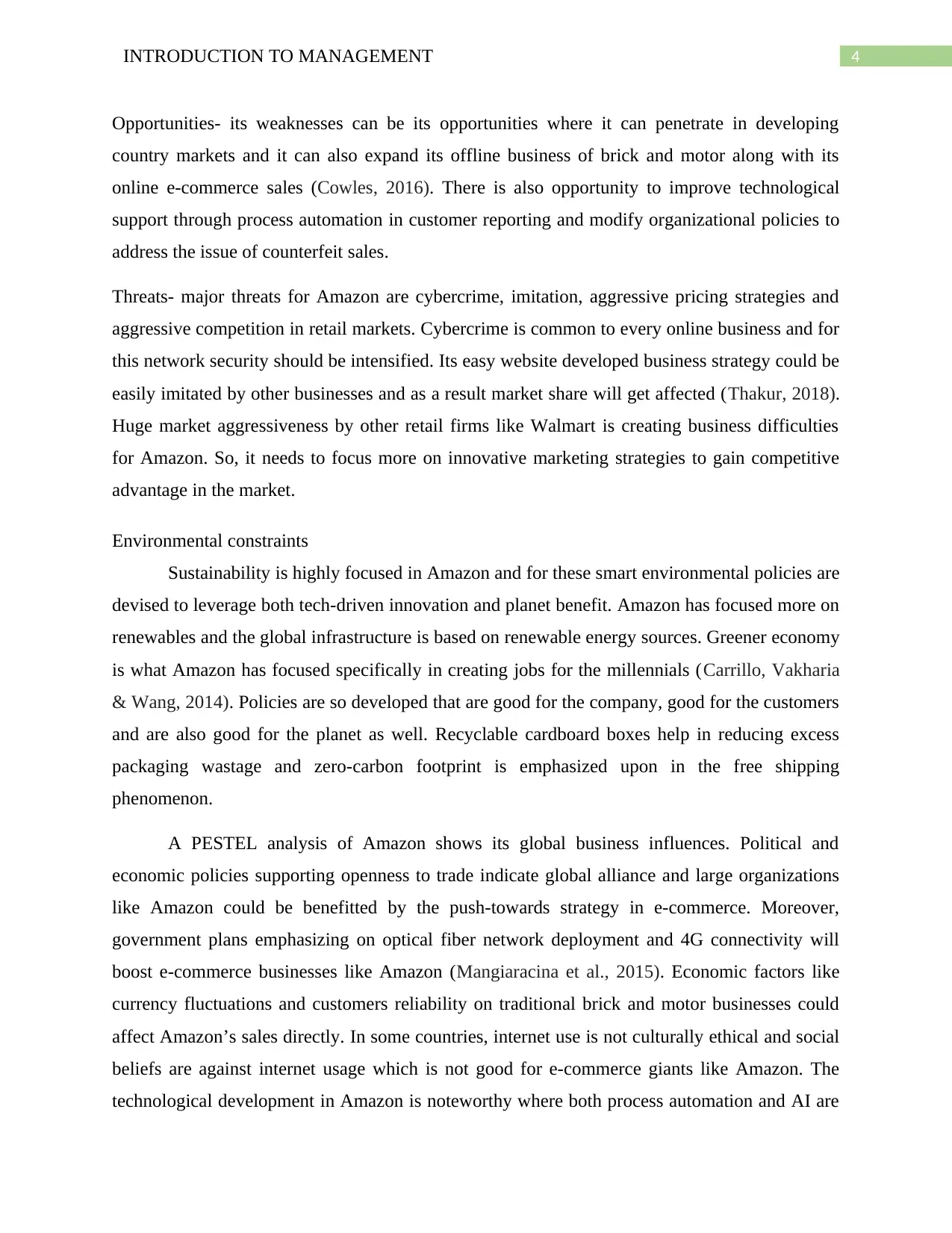
4INTRODUCTION TO MANAGEMENT
Opportunities- its weaknesses can be its opportunities where it can penetrate in developing
country markets and it can also expand its offline business of brick and motor along with its
online e-commerce sales (Cowles, 2016). There is also opportunity to improve technological
support through process automation in customer reporting and modify organizational policies to
address the issue of counterfeit sales.
Threats- major threats for Amazon are cybercrime, imitation, aggressive pricing strategies and
aggressive competition in retail markets. Cybercrime is common to every online business and for
this network security should be intensified. Its easy website developed business strategy could be
easily imitated by other businesses and as a result market share will get affected (Thakur, 2018).
Huge market aggressiveness by other retail firms like Walmart is creating business difficulties
for Amazon. So, it needs to focus more on innovative marketing strategies to gain competitive
advantage in the market.
Environmental constraints
Sustainability is highly focused in Amazon and for these smart environmental policies are
devised to leverage both tech-driven innovation and planet benefit. Amazon has focused more on
renewables and the global infrastructure is based on renewable energy sources. Greener economy
is what Amazon has focused specifically in creating jobs for the millennials (Carrillo, Vakharia
& Wang, 2014). Policies are so developed that are good for the company, good for the customers
and are also good for the planet as well. Recyclable cardboard boxes help in reducing excess
packaging wastage and zero-carbon footprint is emphasized upon in the free shipping
phenomenon.
A PESTEL analysis of Amazon shows its global business influences. Political and
economic policies supporting openness to trade indicate global alliance and large organizations
like Amazon could be benefitted by the push-towards strategy in e-commerce. Moreover,
government plans emphasizing on optical fiber network deployment and 4G connectivity will
boost e-commerce businesses like Amazon (Mangiaracina et al., 2015). Economic factors like
currency fluctuations and customers reliability on traditional brick and motor businesses could
affect Amazon’s sales directly. In some countries, internet use is not culturally ethical and social
beliefs are against internet usage which is not good for e-commerce giants like Amazon. The
technological development in Amazon is noteworthy where both process automation and AI are
Opportunities- its weaknesses can be its opportunities where it can penetrate in developing
country markets and it can also expand its offline business of brick and motor along with its
online e-commerce sales (Cowles, 2016). There is also opportunity to improve technological
support through process automation in customer reporting and modify organizational policies to
address the issue of counterfeit sales.
Threats- major threats for Amazon are cybercrime, imitation, aggressive pricing strategies and
aggressive competition in retail markets. Cybercrime is common to every online business and for
this network security should be intensified. Its easy website developed business strategy could be
easily imitated by other businesses and as a result market share will get affected (Thakur, 2018).
Huge market aggressiveness by other retail firms like Walmart is creating business difficulties
for Amazon. So, it needs to focus more on innovative marketing strategies to gain competitive
advantage in the market.
Environmental constraints
Sustainability is highly focused in Amazon and for these smart environmental policies are
devised to leverage both tech-driven innovation and planet benefit. Amazon has focused more on
renewables and the global infrastructure is based on renewable energy sources. Greener economy
is what Amazon has focused specifically in creating jobs for the millennials (Carrillo, Vakharia
& Wang, 2014). Policies are so developed that are good for the company, good for the customers
and are also good for the planet as well. Recyclable cardboard boxes help in reducing excess
packaging wastage and zero-carbon footprint is emphasized upon in the free shipping
phenomenon.
A PESTEL analysis of Amazon shows its global business influences. Political and
economic policies supporting openness to trade indicate global alliance and large organizations
like Amazon could be benefitted by the push-towards strategy in e-commerce. Moreover,
government plans emphasizing on optical fiber network deployment and 4G connectivity will
boost e-commerce businesses like Amazon (Mangiaracina et al., 2015). Economic factors like
currency fluctuations and customers reliability on traditional brick and motor businesses could
affect Amazon’s sales directly. In some countries, internet use is not culturally ethical and social
beliefs are against internet usage which is not good for e-commerce giants like Amazon. The
technological development in Amazon is noteworthy where both process automation and AI are
Secure Best Marks with AI Grader
Need help grading? Try our AI Grader for instant feedback on your assignments.
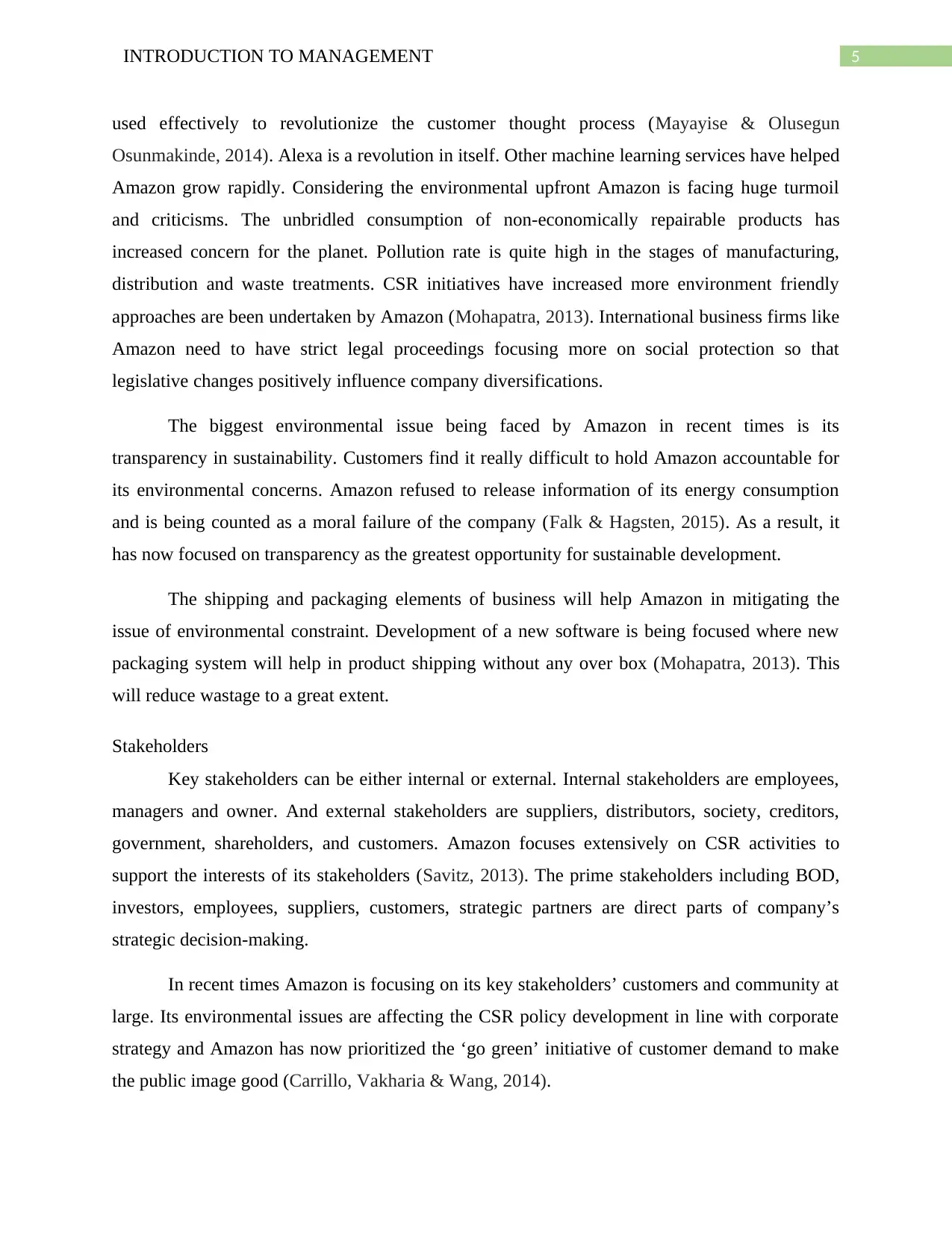
5INTRODUCTION TO MANAGEMENT
used effectively to revolutionize the customer thought process (Mayayise & Olusegun
Osunmakinde, 2014). Alexa is a revolution in itself. Other machine learning services have helped
Amazon grow rapidly. Considering the environmental upfront Amazon is facing huge turmoil
and criticisms. The unbridled consumption of non-economically repairable products has
increased concern for the planet. Pollution rate is quite high in the stages of manufacturing,
distribution and waste treatments. CSR initiatives have increased more environment friendly
approaches are been undertaken by Amazon (Mohapatra, 2013). International business firms like
Amazon need to have strict legal proceedings focusing more on social protection so that
legislative changes positively influence company diversifications.
The biggest environmental issue being faced by Amazon in recent times is its
transparency in sustainability. Customers find it really difficult to hold Amazon accountable for
its environmental concerns. Amazon refused to release information of its energy consumption
and is being counted as a moral failure of the company (Falk & Hagsten, 2015). As a result, it
has now focused on transparency as the greatest opportunity for sustainable development.
The shipping and packaging elements of business will help Amazon in mitigating the
issue of environmental constraint. Development of a new software is being focused where new
packaging system will help in product shipping without any over box (Mohapatra, 2013). This
will reduce wastage to a great extent.
Stakeholders
Key stakeholders can be either internal or external. Internal stakeholders are employees,
managers and owner. And external stakeholders are suppliers, distributors, society, creditors,
government, shareholders, and customers. Amazon focuses extensively on CSR activities to
support the interests of its stakeholders (Savitz, 2013). The prime stakeholders including BOD,
investors, employees, suppliers, customers, strategic partners are direct parts of company’s
strategic decision-making.
In recent times Amazon is focusing on its key stakeholders’ customers and community at
large. Its environmental issues are affecting the CSR policy development in line with corporate
strategy and Amazon has now prioritized the ‘go green’ initiative of customer demand to make
the public image good (Carrillo, Vakharia & Wang, 2014).
used effectively to revolutionize the customer thought process (Mayayise & Olusegun
Osunmakinde, 2014). Alexa is a revolution in itself. Other machine learning services have helped
Amazon grow rapidly. Considering the environmental upfront Amazon is facing huge turmoil
and criticisms. The unbridled consumption of non-economically repairable products has
increased concern for the planet. Pollution rate is quite high in the stages of manufacturing,
distribution and waste treatments. CSR initiatives have increased more environment friendly
approaches are been undertaken by Amazon (Mohapatra, 2013). International business firms like
Amazon need to have strict legal proceedings focusing more on social protection so that
legislative changes positively influence company diversifications.
The biggest environmental issue being faced by Amazon in recent times is its
transparency in sustainability. Customers find it really difficult to hold Amazon accountable for
its environmental concerns. Amazon refused to release information of its energy consumption
and is being counted as a moral failure of the company (Falk & Hagsten, 2015). As a result, it
has now focused on transparency as the greatest opportunity for sustainable development.
The shipping and packaging elements of business will help Amazon in mitigating the
issue of environmental constraint. Development of a new software is being focused where new
packaging system will help in product shipping without any over box (Mohapatra, 2013). This
will reduce wastage to a great extent.
Stakeholders
Key stakeholders can be either internal or external. Internal stakeholders are employees,
managers and owner. And external stakeholders are suppliers, distributors, society, creditors,
government, shareholders, and customers. Amazon focuses extensively on CSR activities to
support the interests of its stakeholders (Savitz, 2013). The prime stakeholders including BOD,
investors, employees, suppliers, customers, strategic partners are direct parts of company’s
strategic decision-making.
In recent times Amazon is focusing on its key stakeholders’ customers and community at
large. Its environmental issues are affecting the CSR policy development in line with corporate
strategy and Amazon has now prioritized the ‘go green’ initiative of customer demand to make
the public image good (Carrillo, Vakharia & Wang, 2014).

6INTRODUCTION TO MANAGEMENT
Organizational structure and design
The organizational chart of Amazon is attached in the appendix section.
The organizational structure in Amazon is mechanistic and is a functional organizational
structure. The functional structure emphasis on business functions as bases for communication
among the various organizational components. The significant characteristics of the corporate
structure of Amazon are global function-based groups support, hierarchical support and
geographic divisional support (Mayayise & Olusegun Osunmakinde, 2014). Its large structure is
responsible for its hierarchical framework where information flows in vertical direction generally
from top strategic managers to lower operational managers. Work specialization is based on
vertical chain of command and span of control is quite higher. Decision-making process is
centralized and the visionary leadership of the CEO, Jeff Bezos has helped Amazon to be
flexible to changes and have increased market adaptability for long run success (Cowles, 2016).
Motivating employees
In Amazon employees are motivated by using monetary reward system and reverse
psychological effect of ‘pay to quit’ which enhances career choice opportunities. In this context
both Maslow’s theory of needs and Herzberg’s two factor theory will be useful in considering
employee motivation in Amazon (Ganta, 2014). If employees are more satisfied in their works
then they tend to be more productive and are committed to their organizations more. Job
satisfaction and motivation are closely linked to each other and managers need to focus on these
two factors for increasing employees’ job performances (Gerhart & Fang, 2015). Also,
McGregor’s theory Y should be focused upon to support increased employee performance.
Various frameworks of motivational theories useful in the context of Amazon are provided in
appendix section.
Recommendations
Employee motivation to work is highly recommended for Amazon as current issues in
areas of increased retail business competitions and environmental concerns has increased
employees job security issues based on work culture (Noe et al., 2017). The work culture in
Amazon has serious loopholes which is fatal for employee retention and motivation of theirs.
The hierarchy of command should be more flexible in dealing with employees and their
satisfaction needs should be emphasized more. Only monetary reward is not enough to support
Organizational structure and design
The organizational chart of Amazon is attached in the appendix section.
The organizational structure in Amazon is mechanistic and is a functional organizational
structure. The functional structure emphasis on business functions as bases for communication
among the various organizational components. The significant characteristics of the corporate
structure of Amazon are global function-based groups support, hierarchical support and
geographic divisional support (Mayayise & Olusegun Osunmakinde, 2014). Its large structure is
responsible for its hierarchical framework where information flows in vertical direction generally
from top strategic managers to lower operational managers. Work specialization is based on
vertical chain of command and span of control is quite higher. Decision-making process is
centralized and the visionary leadership of the CEO, Jeff Bezos has helped Amazon to be
flexible to changes and have increased market adaptability for long run success (Cowles, 2016).
Motivating employees
In Amazon employees are motivated by using monetary reward system and reverse
psychological effect of ‘pay to quit’ which enhances career choice opportunities. In this context
both Maslow’s theory of needs and Herzberg’s two factor theory will be useful in considering
employee motivation in Amazon (Ganta, 2014). If employees are more satisfied in their works
then they tend to be more productive and are committed to their organizations more. Job
satisfaction and motivation are closely linked to each other and managers need to focus on these
two factors for increasing employees’ job performances (Gerhart & Fang, 2015). Also,
McGregor’s theory Y should be focused upon to support increased employee performance.
Various frameworks of motivational theories useful in the context of Amazon are provided in
appendix section.
Recommendations
Employee motivation to work is highly recommended for Amazon as current issues in
areas of increased retail business competitions and environmental concerns has increased
employees job security issues based on work culture (Noe et al., 2017). The work culture in
Amazon has serious loopholes which is fatal for employee retention and motivation of theirs.
The hierarchy of command should be more flexible in dealing with employees and their
satisfaction needs should be emphasized more. Only monetary reward is not enough to support
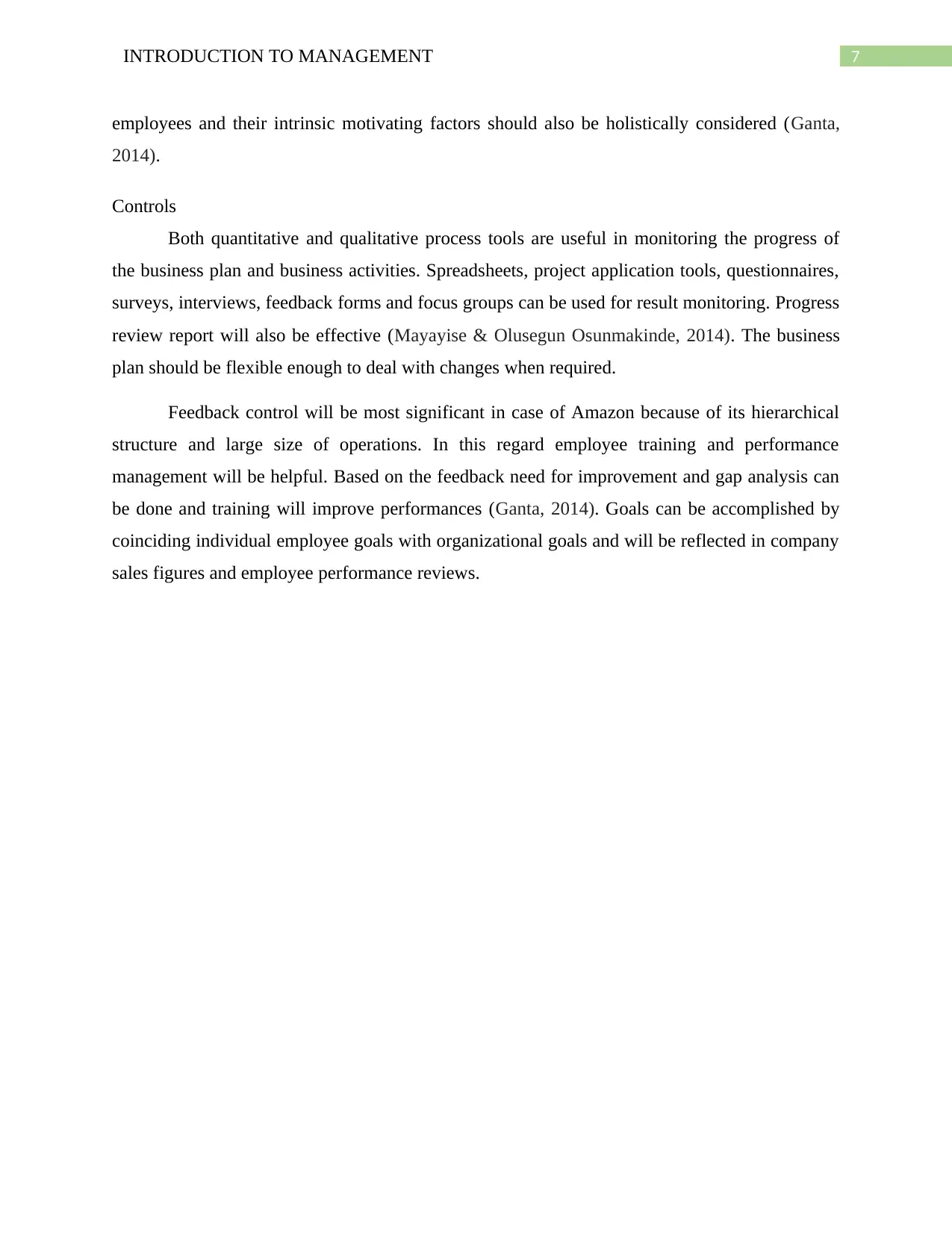
7INTRODUCTION TO MANAGEMENT
employees and their intrinsic motivating factors should also be holistically considered (Ganta,
2014).
Controls
Both quantitative and qualitative process tools are useful in monitoring the progress of
the business plan and business activities. Spreadsheets, project application tools, questionnaires,
surveys, interviews, feedback forms and focus groups can be used for result monitoring. Progress
review report will also be effective (Mayayise & Olusegun Osunmakinde, 2014). The business
plan should be flexible enough to deal with changes when required.
Feedback control will be most significant in case of Amazon because of its hierarchical
structure and large size of operations. In this regard employee training and performance
management will be helpful. Based on the feedback need for improvement and gap analysis can
be done and training will improve performances (Ganta, 2014). Goals can be accomplished by
coinciding individual employee goals with organizational goals and will be reflected in company
sales figures and employee performance reviews.
employees and their intrinsic motivating factors should also be holistically considered (Ganta,
2014).
Controls
Both quantitative and qualitative process tools are useful in monitoring the progress of
the business plan and business activities. Spreadsheets, project application tools, questionnaires,
surveys, interviews, feedback forms and focus groups can be used for result monitoring. Progress
review report will also be effective (Mayayise & Olusegun Osunmakinde, 2014). The business
plan should be flexible enough to deal with changes when required.
Feedback control will be most significant in case of Amazon because of its hierarchical
structure and large size of operations. In this regard employee training and performance
management will be helpful. Based on the feedback need for improvement and gap analysis can
be done and training will improve performances (Ganta, 2014). Goals can be accomplished by
coinciding individual employee goals with organizational goals and will be reflected in company
sales figures and employee performance reviews.
Paraphrase This Document
Need a fresh take? Get an instant paraphrase of this document with our AI Paraphraser
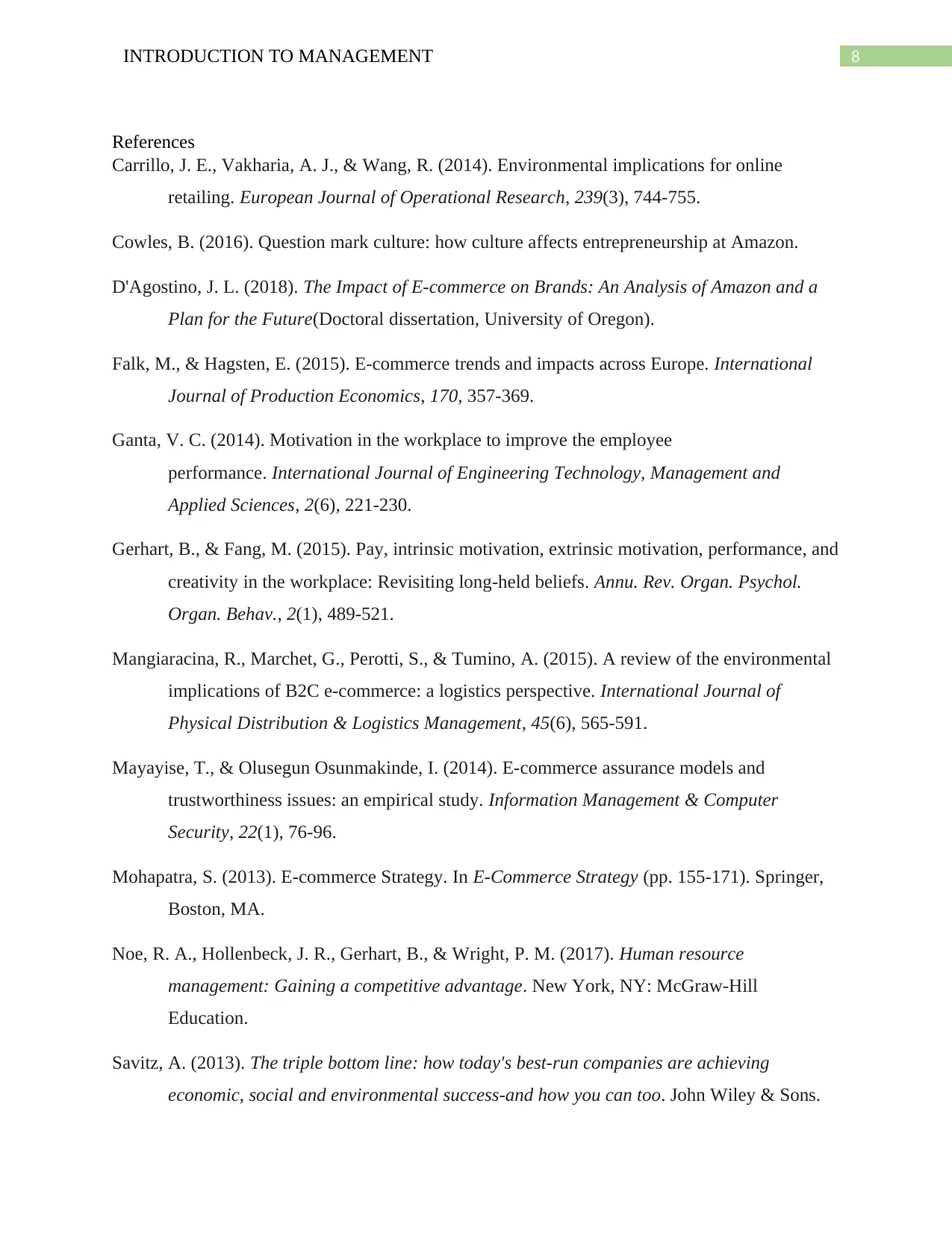
8INTRODUCTION TO MANAGEMENT
References
Carrillo, J. E., Vakharia, A. J., & Wang, R. (2014). Environmental implications for online
retailing. European Journal of Operational Research, 239(3), 744-755.
Cowles, B. (2016). Question mark culture: how culture affects entrepreneurship at Amazon.
D'Agostino, J. L. (2018). The Impact of E-commerce on Brands: An Analysis of Amazon and a
Plan for the Future(Doctoral dissertation, University of Oregon).
Falk, M., & Hagsten, E. (2015). E-commerce trends and impacts across Europe. International
Journal of Production Economics, 170, 357-369.
Ganta, V. C. (2014). Motivation in the workplace to improve the employee
performance. International Journal of Engineering Technology, Management and
Applied Sciences, 2(6), 221-230.
Gerhart, B., & Fang, M. (2015). Pay, intrinsic motivation, extrinsic motivation, performance, and
creativity in the workplace: Revisiting long-held beliefs. Annu. Rev. Organ. Psychol.
Organ. Behav., 2(1), 489-521.
Mangiaracina, R., Marchet, G., Perotti, S., & Tumino, A. (2015). A review of the environmental
implications of B2C e-commerce: a logistics perspective. International Journal of
Physical Distribution & Logistics Management, 45(6), 565-591.
Mayayise, T., & Olusegun Osunmakinde, I. (2014). E-commerce assurance models and
trustworthiness issues: an empirical study. Information Management & Computer
Security, 22(1), 76-96.
Mohapatra, S. (2013). E-commerce Strategy. In E-Commerce Strategy (pp. 155-171). Springer,
Boston, MA.
Noe, R. A., Hollenbeck, J. R., Gerhart, B., & Wright, P. M. (2017). Human resource
management: Gaining a competitive advantage. New York, NY: McGraw-Hill
Education.
Savitz, A. (2013). The triple bottom line: how today's best-run companies are achieving
economic, social and environmental success-and how you can too. John Wiley & Sons.
References
Carrillo, J. E., Vakharia, A. J., & Wang, R. (2014). Environmental implications for online
retailing. European Journal of Operational Research, 239(3), 744-755.
Cowles, B. (2016). Question mark culture: how culture affects entrepreneurship at Amazon.
D'Agostino, J. L. (2018). The Impact of E-commerce on Brands: An Analysis of Amazon and a
Plan for the Future(Doctoral dissertation, University of Oregon).
Falk, M., & Hagsten, E. (2015). E-commerce trends and impacts across Europe. International
Journal of Production Economics, 170, 357-369.
Ganta, V. C. (2014). Motivation in the workplace to improve the employee
performance. International Journal of Engineering Technology, Management and
Applied Sciences, 2(6), 221-230.
Gerhart, B., & Fang, M. (2015). Pay, intrinsic motivation, extrinsic motivation, performance, and
creativity in the workplace: Revisiting long-held beliefs. Annu. Rev. Organ. Psychol.
Organ. Behav., 2(1), 489-521.
Mangiaracina, R., Marchet, G., Perotti, S., & Tumino, A. (2015). A review of the environmental
implications of B2C e-commerce: a logistics perspective. International Journal of
Physical Distribution & Logistics Management, 45(6), 565-591.
Mayayise, T., & Olusegun Osunmakinde, I. (2014). E-commerce assurance models and
trustworthiness issues: an empirical study. Information Management & Computer
Security, 22(1), 76-96.
Mohapatra, S. (2013). E-commerce Strategy. In E-Commerce Strategy (pp. 155-171). Springer,
Boston, MA.
Noe, R. A., Hollenbeck, J. R., Gerhart, B., & Wright, P. M. (2017). Human resource
management: Gaining a competitive advantage. New York, NY: McGraw-Hill
Education.
Savitz, A. (2013). The triple bottom line: how today's best-run companies are achieving
economic, social and environmental success-and how you can too. John Wiley & Sons.
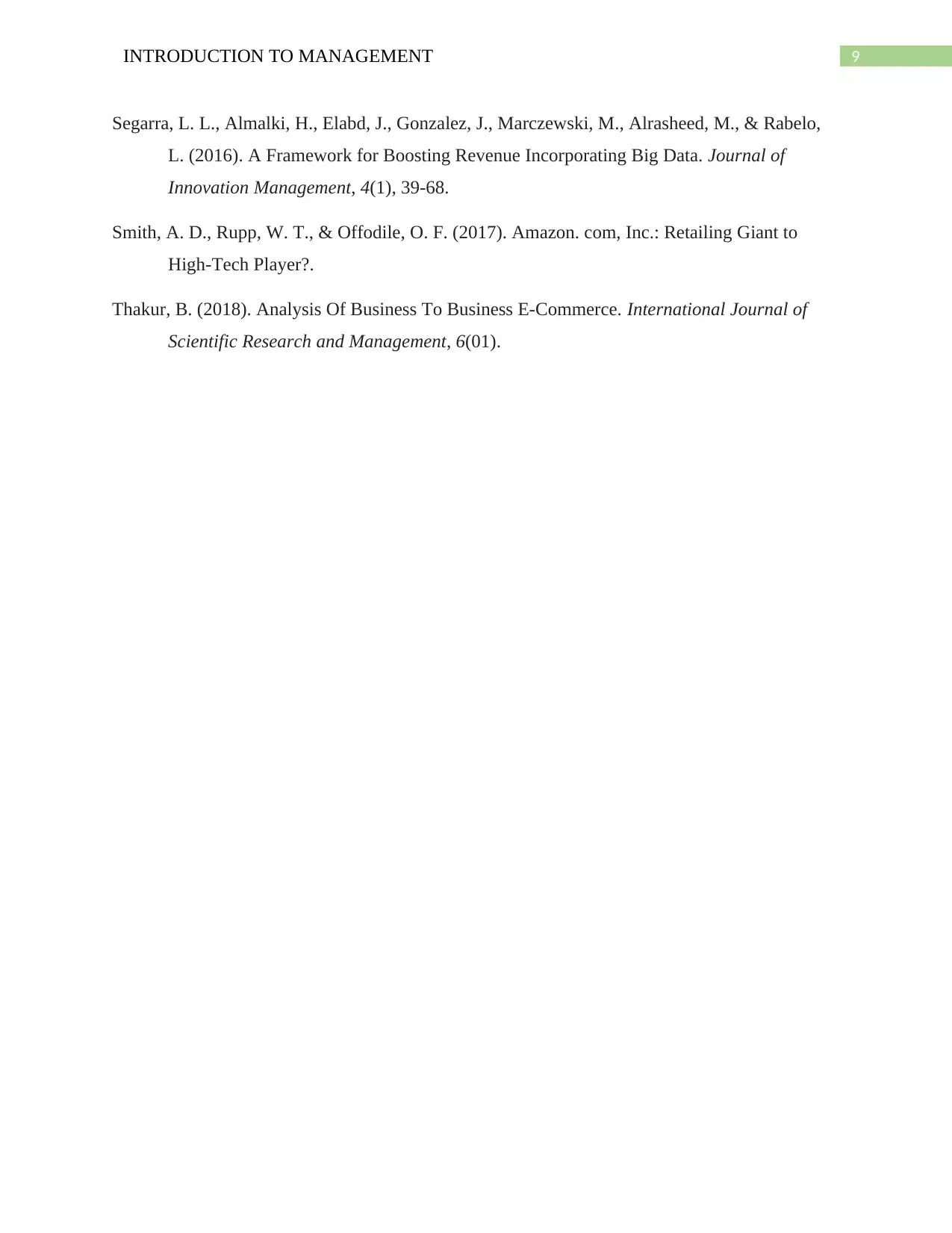
9INTRODUCTION TO MANAGEMENT
Segarra, L. L., Almalki, H., Elabd, J., Gonzalez, J., Marczewski, M., Alrasheed, M., & Rabelo,
L. (2016). A Framework for Boosting Revenue Incorporating Big Data. Journal of
Innovation Management, 4(1), 39-68.
Smith, A. D., Rupp, W. T., & Offodile, O. F. (2017). Amazon. com, Inc.: Retailing Giant to
High-Tech Player?.
Thakur, B. (2018). Analysis Of Business To Business E-Commerce. International Journal of
Scientific Research and Management, 6(01).
Segarra, L. L., Almalki, H., Elabd, J., Gonzalez, J., Marczewski, M., Alrasheed, M., & Rabelo,
L. (2016). A Framework for Boosting Revenue Incorporating Big Data. Journal of
Innovation Management, 4(1), 39-68.
Smith, A. D., Rupp, W. T., & Offodile, O. F. (2017). Amazon. com, Inc.: Retailing Giant to
High-Tech Player?.
Thakur, B. (2018). Analysis Of Business To Business E-Commerce. International Journal of
Scientific Research and Management, 6(01).
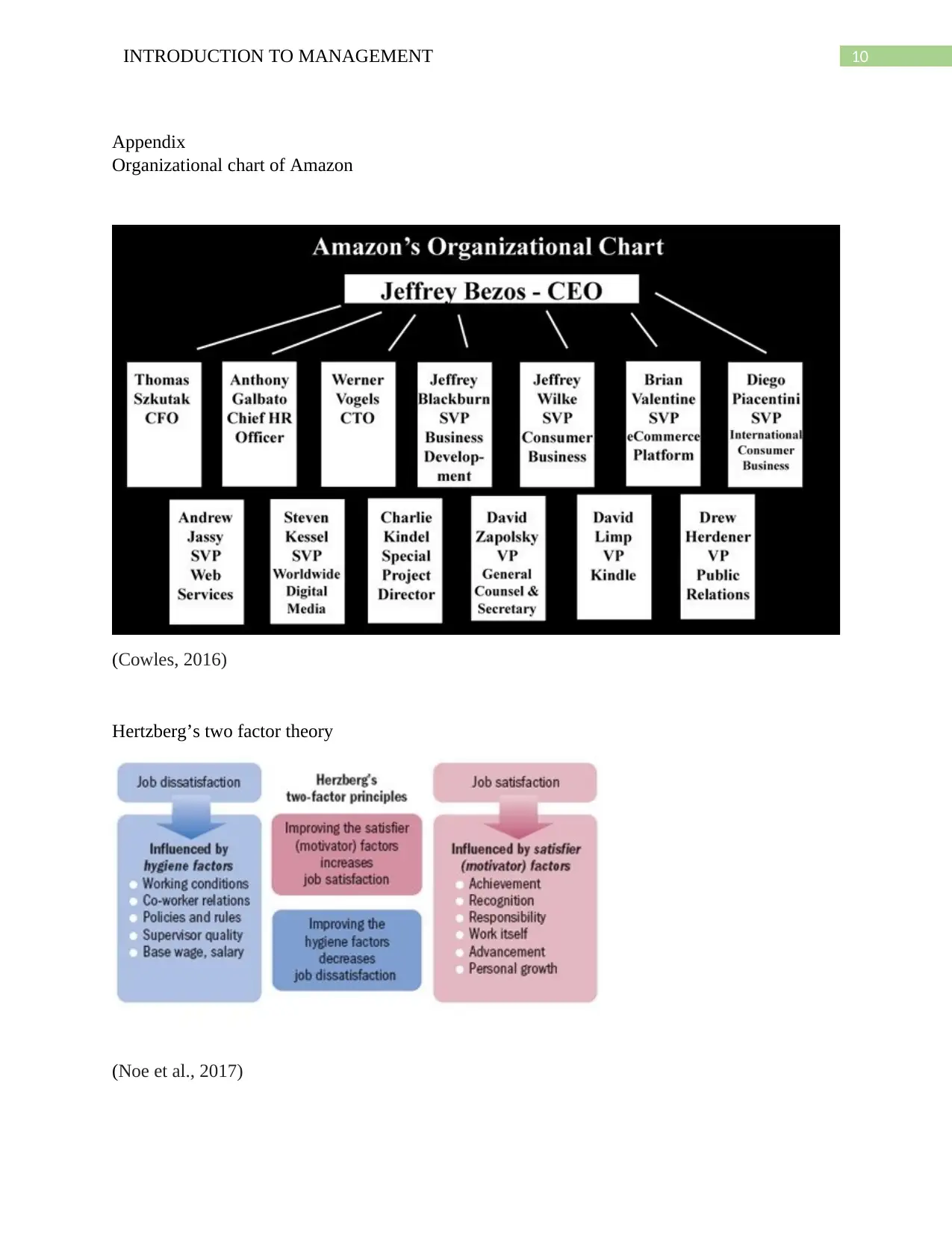
10INTRODUCTION TO MANAGEMENT
Appendix
Organizational chart of Amazon
(Cowles, 2016)
Hertzberg’s two factor theory
(Noe et al., 2017)
Appendix
Organizational chart of Amazon
(Cowles, 2016)
Hertzberg’s two factor theory
(Noe et al., 2017)
Secure Best Marks with AI Grader
Need help grading? Try our AI Grader for instant feedback on your assignments.
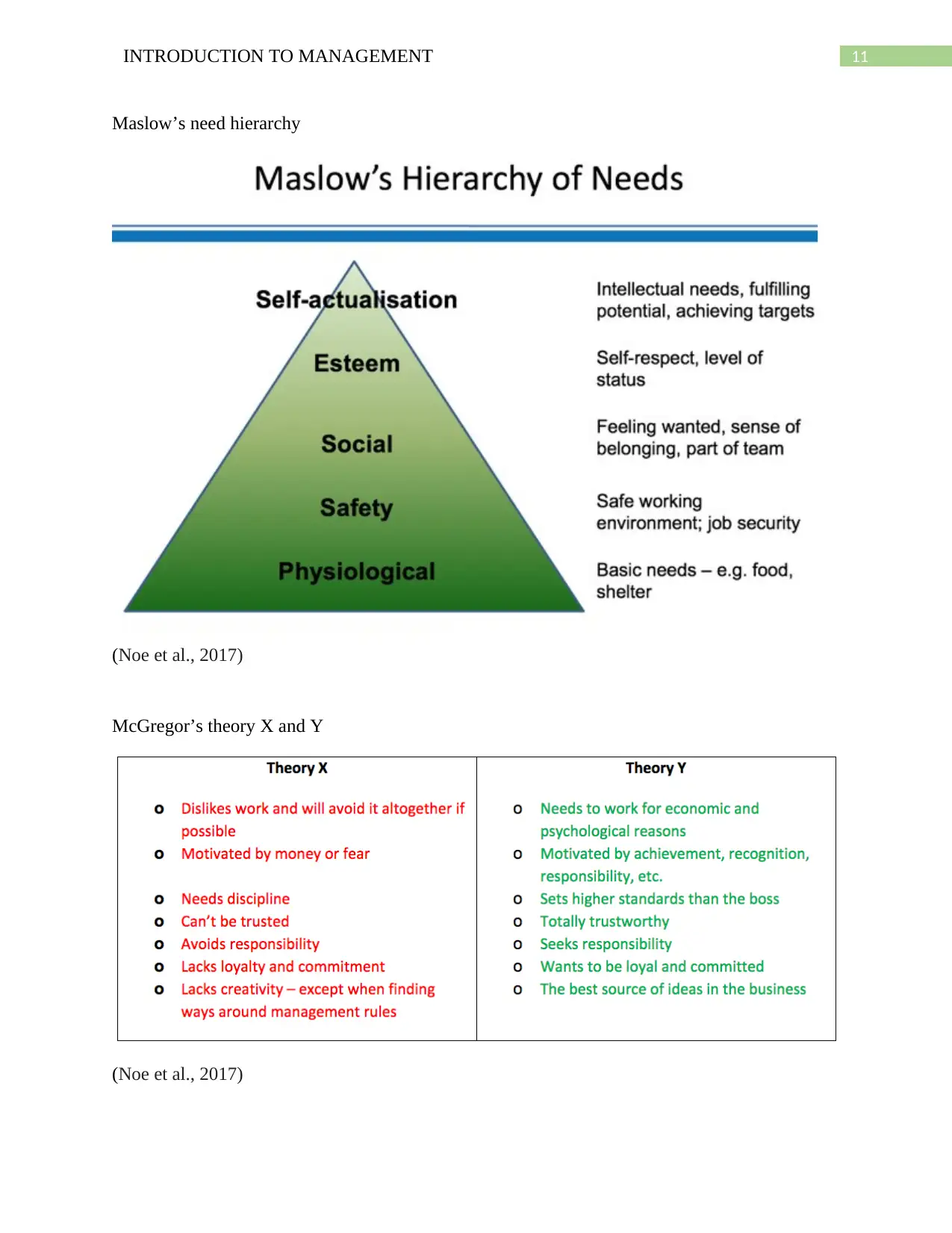
11INTRODUCTION TO MANAGEMENT
Maslow’s need hierarchy
(Noe et al., 2017)
McGregor’s theory X and Y
(Noe et al., 2017)
Maslow’s need hierarchy
(Noe et al., 2017)
McGregor’s theory X and Y
(Noe et al., 2017)
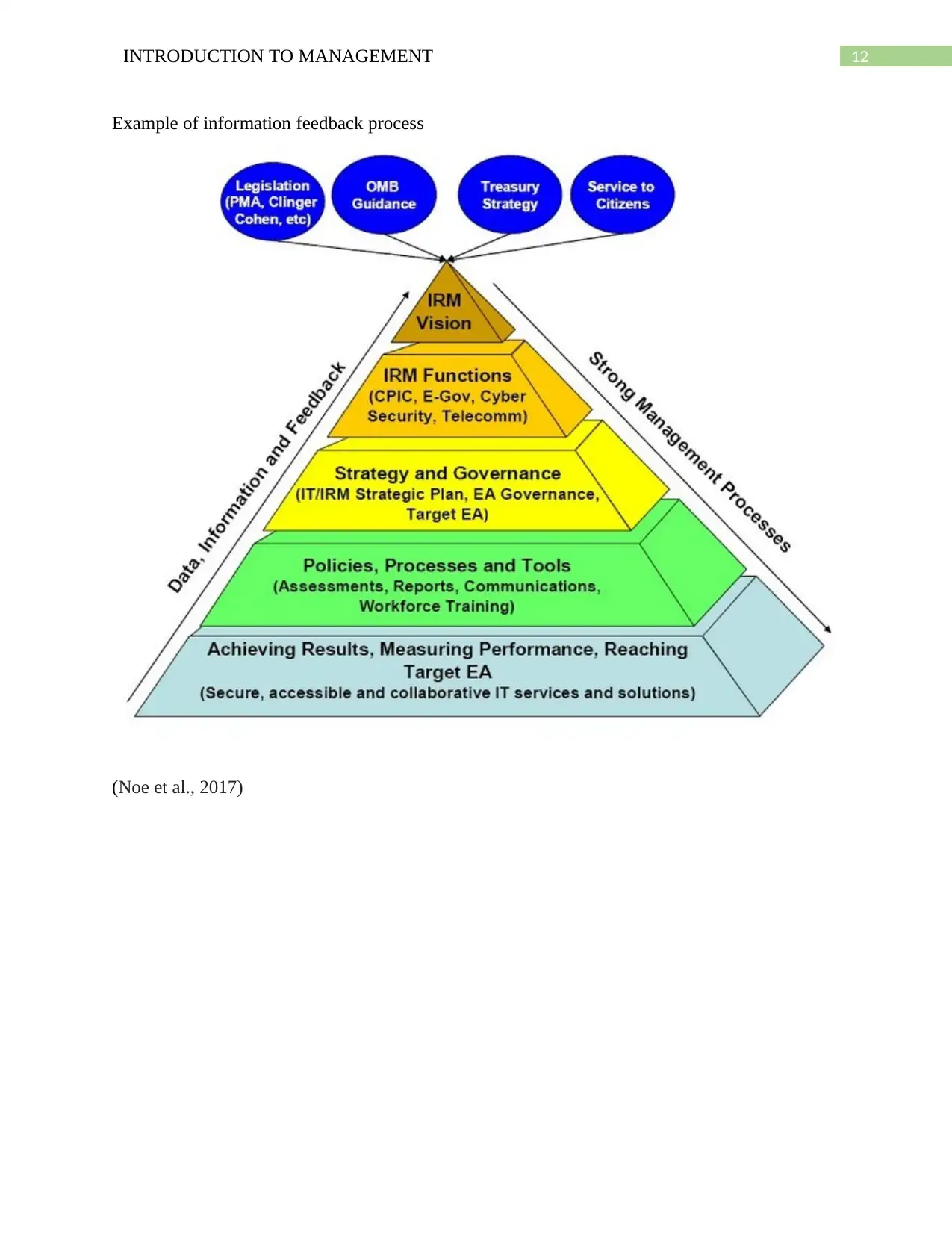
12INTRODUCTION TO MANAGEMENT
Example of information feedback process
(Noe et al., 2017)
Example of information feedback process
(Noe et al., 2017)
1 out of 12
Related Documents
Your All-in-One AI-Powered Toolkit for Academic Success.
+13062052269
info@desklib.com
Available 24*7 on WhatsApp / Email
![[object Object]](/_next/static/media/star-bottom.7253800d.svg)
Unlock your academic potential
© 2024 | Zucol Services PVT LTD | All rights reserved.





